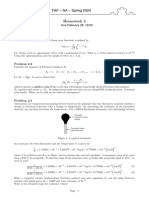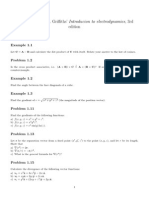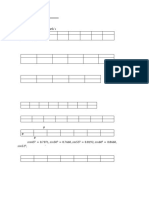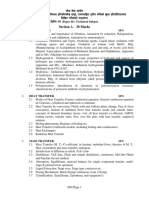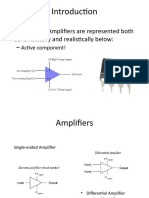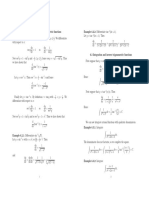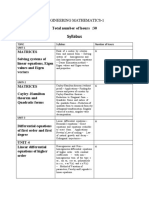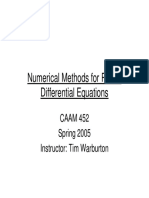ASSIGNMENT - V (Numerical Differentiation and Integration + Matrices and System of Linear Equations) Course: MCSC 202
Uploaded by
Rojan PradhanASSIGNMENT - V (Numerical Differentiation and Integration + Matrices and System of Linear Equations) Course: MCSC 202
Uploaded by
Rojan PradhanIssue Date: Due Date: One week from the issue date
——————————————————————————————————————————–
ASSIGNMENT - V(Numerical differentiation and integration + Matrices and system of
linear equations)
Course: MCSC 202
h i h 2 i
dy d y
Problem 1 Use Newton’s backward Interpolation formula to derive the relation for dx , dx 2
h 3 i x=x n x=xn
d y
and dx3 . Find the first and second derivatives of f (x) at x = 0.1 from the following table.
x=xn
x
0.1 0.2 0.3 0.4
f(x)
1.10517 1.22140 1.34986 1.49182
h i h 2 i
dy d y
Problem 2 Write the expression for dx and dx 2 due to Stirling. Use these expressions to
x=x0 x=x0
find the first derivative and second derivative at the point x = 1 from the following table for the function
y = sinx. Also determine the error.
x 0.7 0.8 0.9 1.0 1.1 1.2 1.3
f(x) .644218 .717356 .783327 .841471 .891207 .932039 .963558
Problem 3 The distances travelled by a rocket at different times are as given below:
t 0 1 2 3 4 5
s 0 3 7 15 38 50
Extimate the rocket’s velocity and acceleration for each value of t.
Problem 4 Calculate the first and second derivatives of lnx at x = 500.
x 500 510 520 530 540 550
lnx 6.214608 0.234411 6.253829 6.272877 6.291569 6.309918
Also determine the error.
Problem 5 Derive Trapezoidal rule, Simpson’s 1/3 rule and Simpson’s 3/8 rule for the numerical inte-
Rb R3
gration of a f (x)dx. Estimate the value of the integral 1 x1 dx using appropriate Simpson’s rule with 4
strips and 8 strips. Determine the error by direct integration.
Problem 6 The velocity v(km/min) of a train with initial velocity 1 km/hr is given at fixed intervals of
time t in minutes as follows:
t 0 0.1 0.2 0.3 0.4 0.5 0.6 0.7 0.8 0.9 1.0
v 1.0 1.2 1.4 1.6 1.8 2.0 2.2 2.4 2.6 2.8 3.0
Estimate approximately the distance covered by a train in 1.0 minute by Trapezoidal and Simpson’s 1/3
rules.
R1 2
Problem 7 Evaluate 0 e−x dx by Trapezoidal and Simpson’s 1/3 rules.
R 3.2 R 2.6 1
Problem 8 Find the value of the double integral 2 1 x+y dydx using Trapezoidal and Simpson rule.
Aslo determine the error.
R1 R2
Problem 9 Evaluate the double integral 0 1 (1+x22xy )(1+y 2 ) dy dx using (i) the trapezoidal rule with h =
k = 0.25 (ii) the simpson’s 1/3-rule with h = k = 0.25. Compare the results obtained with the exact
solution.
Problem 10 Solve the system, correct to 3 decimal places, of the system 27x+6y−z = 85, 6x+15y+2z =
72, x + y + 54z = 110 using Jacobi and Gauss-Seidel methods. Also solve the system by LU decomposition
method taking (a)lii = 1 for all i and (b)uii = 1 for all i.
Problem 11 Solve the system 2x1 − x2 = 1, −x1 + 2x2 − x3 = 0, −x2 + 2x3 − x4 = 0, −x3 + 2x4 = 1 by
Thomas algorithm method and LU decomposition method with (a)lii = 1 for all i and (b)uii = 1 for all i.
You might also like
- Engineering Mathematics I (MATH 1101) RCSNo ratings yetEngineering Mathematics I (MATH 1101) RCS2 pages
- Sample Communications Officer Cover Letter: Minnie PresserNo ratings yetSample Communications Officer Cover Letter: Minnie Presser1 page
- MA288-NM and Series Sol_Assignment-I(Midterm)No ratings yetMA288-NM and Series Sol_Assignment-I(Midterm)3 pages
- Numerical Integration and DifferentiationNo ratings yetNumerical Integration and Differentiation2 pages
- Nepal Engineering College Changunarayan, BhaktapurNo ratings yetNepal Engineering College Changunarayan, Bhaktapur4 pages
- Question Bank (2014) MAM-581, Engineering Mathematics V: Unit#2 16No ratings yetQuestion Bank (2014) MAM-581, Engineering Mathematics V: Unit#2 167 pages
- Computational Methods in Engineering: Code No: MA1902 M. Tech I Semester Regular Examinations, April 2015No ratings yetComputational Methods in Engineering: Code No: MA1902 M. Tech I Semester Regular Examinations, April 20152 pages
- Mathematics For Engineers PDF Ebook-1001-1005No ratings yetMathematics For Engineers PDF Ebook-1001-10055 pages
- Department of Mathematics and Comuting Numerical Methods Tutorial Sheet-IIINo ratings yetDepartment of Mathematics and Comuting Numerical Methods Tutorial Sheet-III2 pages
- (DE 101) B.Tech. Degree Examination, May 2007: Mxydx NxydyNo ratings yet(DE 101) B.Tech. Degree Examination, May 2007: Mxydx Nxydy16 pages
- Mzumbe University Falculty of Science and Technology MSS 224:numerical Analysis Tutorial Sheet 4No ratings yetMzumbe University Falculty of Science and Technology MSS 224:numerical Analysis Tutorial Sheet 42 pages
- Study - Material - 2021-22 All Papers 1670660608584No ratings yetStudy - Material - 2021-22 All Papers 167066060858418 pages
- Engineering Science 204: Machine Problem No. 1No ratings yetEngineering Science 204: Machine Problem No. 129 pages
- Integration - Unequal Segments, Multiple Integral and Gauss Quad Rule PDFNo ratings yetIntegration - Unequal Segments, Multiple Integral and Gauss Quad Rule PDF30 pages
- Integration - Unequal Segments, Multiple Integral and Gauss Quad RuleNo ratings yetIntegration - Unequal Segments, Multiple Integral and Gauss Quad Rule31 pages
- Mathematics I 2023 November (2019-2023 Admission)No ratings yetMathematics I 2023 November (2019-2023 Admission)3 pages
- Topic 2 First Order Differential EquationsNo ratings yetTopic 2 First Order Differential Equations24 pages
- Ma9214-Applied Mathematics For Engineering Design-R9 2010 JanNo ratings yetMa9214-Applied Mathematics For Engineering Design-R9 2010 Jan5 pages
- Mathematics 1St First Order Linear Differential Equations 2Nd Second Order Linear Differential Equations Laplace Fourier Bessel MathematicsFrom EverandMathematics 1St First Order Linear Differential Equations 2Nd Second Order Linear Differential Equations Laplace Fourier Bessel MathematicsNo ratings yet
- Factoring and Algebra - A Selection of Classic Mathematical Articles Containing Examples and Exercises on the Subject of Algebra (Mathematics Series)From EverandFactoring and Algebra - A Selection of Classic Mathematical Articles Containing Examples and Exercises on the Subject of Algebra (Mathematics Series)No ratings yet
- Student Solutions Manual to Accompany Economic Dynamics in Discrete Time, secondeditionFrom EverandStudent Solutions Manual to Accompany Economic Dynamics in Discrete Time, secondedition4.5/5 (2)
- Chemical Process Safety: Kathmandu UniversityNo ratings yetChemical Process Safety: Kathmandu University16 pages
- Wind Turbines: A Green and Renewable Source of ElectricityNo ratings yetWind Turbines: A Green and Renewable Source of Electricity15 pages
- Comparison Between BJT, FET & Thyristor: Intruder Alarm100% (1)Comparison Between BJT, FET & Thyristor: Intruder Alarm26 pages
- SoS-SoE-17-10-09-Academic Calendar 17-18-FinalNo ratings yetSoS-SoE-17-10-09-Academic Calendar 17-18-Final2 pages
- Lecture 6 (Inverse Trigonometric Functions)No ratings yetLecture 6 (Inverse Trigonometric Functions)29 pages
- Vibration Under General Forcing ConditionsNo ratings yetVibration Under General Forcing Conditions48 pages
- Differentiation of Inverse Trig FunctionsNo ratings yetDifferentiation of Inverse Trig Functions2 pages
- Table of Laplace Transforms: Heaviside Function Dirac Delta FunctionNo ratings yetTable of Laplace Transforms: Heaviside Function Dirac Delta Function1 page
- Raffoul y Applied Mathematics For Scientists and Engineers100% (2)Raffoul y Applied Mathematics For Scientists and Engineers442 pages
- Hyperbolic Tangent Stretching Functions Per M. Vinokur JCP 1983No ratings yetHyperbolic Tangent Stretching Functions Per M. Vinokur JCP 19836 pages
- Review of Differentiation and AntidifferentiationNo ratings yetReview of Differentiation and Antidifferentiation3 pages
- Numerical Methods For Partial Differential Equations: CAAM 452 Spring 2005 Instructor: Tim WarburtonNo ratings yetNumerical Methods For Partial Differential Equations: CAAM 452 Spring 2005 Instructor: Tim Warburton26 pages
- PDF (Free) : National Defence Academy NDA Exam Pattern & SyllabusNo ratings yetPDF (Free) : National Defence Academy NDA Exam Pattern & Syllabus4 pages











